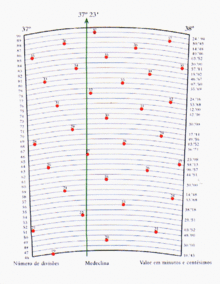Nonius (device)

Nonius is a device, named in honour to its Portuguese author and inventor Pedro Nunes (Latin: Petrus Nonius), created in 1542 as a system for taking fine measurements on the astrolabe.[1] Later on, it was adapted in 1631 by the French mathematician Pierre Vernier, to create the vernier scale.
Technical features

The nonius was used to improve the astrolabe's accuracy. This consisted of a number of concentric circles traced on an instrument and dividing each successive one with one fewer divisions than the adjacent outer circle. Thus the outermost quadrant would comprise 90° in 90 equal divisions, the next inner would have 89 divisions, the next 88 and so on. When an angle was measured, the circle and the division on which the alidade fell was noted. A table was then consulted to provide the exact measure.[2]
Later on it was also used by the astronomer Tycho Brahe who applied the nonius to the astronomic quadrant.[3]
See also
References
- ↑ "Pedro Nunes". Infopédia [em linha]. Porto: Porto Editora. 2015.
- ↑ António Estácio dos Reis. "O conceito de nónio" [The concept of Nonius]. Ciência Viva.
- ↑ António Estácio dos Reis. "Tycho Brahe recorre ao nónio de Pedro Nunes" [Tycho Brahe betakes Pedro Nunes' Nonius]. Ciência Viva.